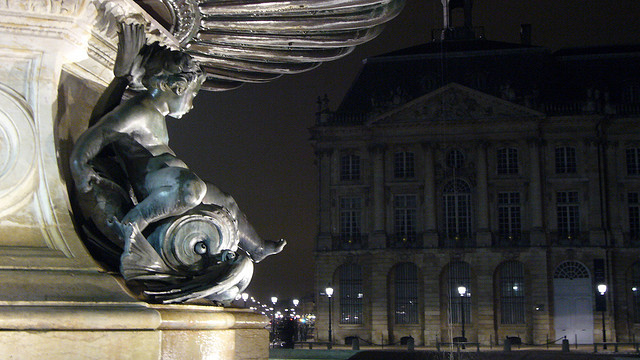By Liz Schaffer
At the turn of the 21st century, Bordeaux was in trouble. Dusty and lifeless, the once majestic stone city was crumbling. So understandably, contemporary Bordeaux feels a little like a phoenix from the ashes. With eons of soot removed from its opulent medieval churches, Baroque-era facades and Art Nouveau town houses and its once questionable docklands transformed into a playground for the hip and design conscious, Bordeaux is once again a European gem.

Surrounded by the ancient vineyards of Aquitaine and one of the world’s largest UNESCO world heritage sites, Bordeaux now blends Old World elegance with cutting-edge design. It’s a classic French beauty with bite.
Timeless Bordeaux shines bright in the heart of the city. Gothic wonders sit amongst narrow streets and century old squares. There’s the St.-Andre Cathedral, which boast sword-like spires; St.-Seurin Basilica, that sits atop an ancient crypt; and the 18th century Place de la Bourse. This particular attraction comes with a modern twist. An ultra thin miroir d’eau, a haven in the heat, reflects the palace-like building, transforming traditional architecture into contemporary art.

Tradition also reigns supreme on the food and wine front. Long famed for its culinary prowess, Bordeaux has foodie treasures aplenty. Frequented by Jacques Chirac, La Tupina, and its cuisine de terroir, is both earthy and rich. Here flavours evolve, the cellar is noble, herbs hang from the ceiling and the menu is thoroughly French ““ lamb cooked for seven hours and French fries cooked in duck fat. Similarly, Chapon Fin, one of Bordeaux’s oldest restaurants, is a Mecca for food and history lovers. Dating back to the time of the revolution in 1789, this Art Nouveau restaurant, which comes complete with a grotto, attracted the Paris elite (who were greeted by valets in period attire) and has had Clemenceau, Sarah Bernhardt and Toulouse Lautrec dine at its tables. Accompanied by perfectly matched wine, their degustation menu is bold, inventive and blissful.

History also runs thick in the surrounding Chateaus and vineyards. Built largely from stone and prone to glowing in the sunlight, these building, and their wineries, are both imposing and beautiful and come complete with manicured gardens and rich aromas. Wineries can only be visited by appointment so it’s best to join a tour. BordoVino offers small trips with young, wine-loving guides who know the area’s history, impart their wine tasting knowledge (one must see, smell, swirl, smell and savour) and hold rather unconventional degrees.

It’s the converted docks alone that prove Bordeaux is no longer “˜La Belle Endormie’. Here an old warehouse the once housed German submarines now hold regular art exhibitions, Le Garage Moderne, a junk filled hanger, doubles as a contemporary art gallery and Fonds Regional d’Art Contemporain, which collects the works of contemporary artists, take to heart Bordeaux’s modern sensibility. The piece de la modern resistance is Seeko’o Hotel. With a jagged white exterior that plays with light and shadow, high design décor, electric gadgetry aplenty, mirrored ceilings and a chic air, a night spent here feels like a night spent in a living art instillation. This unorthodox urban landmark proves that Bordeaux can do contemporary. And it can do it remarkably well.
 About the Writer
About the Writer
Liz Schaffer is an Australian-born freelance travel writer and photographer who set up in London hoping to live behind a blue door and fall in love with famous faces. When not pounding the pavements of Notting Hill she’s lost in Antarctica, climbing hills in Patagonia, swimming in the Adriatic and eating her way around Italy. Her work has appeared in Yen Magazine, International Traveller, Sublime, Lost in London and Australian Traveller. Read her articles on her personal blog: http://lizschaffer.wordpress.com/
Feature Photo by Ted Drake
All other photos by Liz Schaffer




